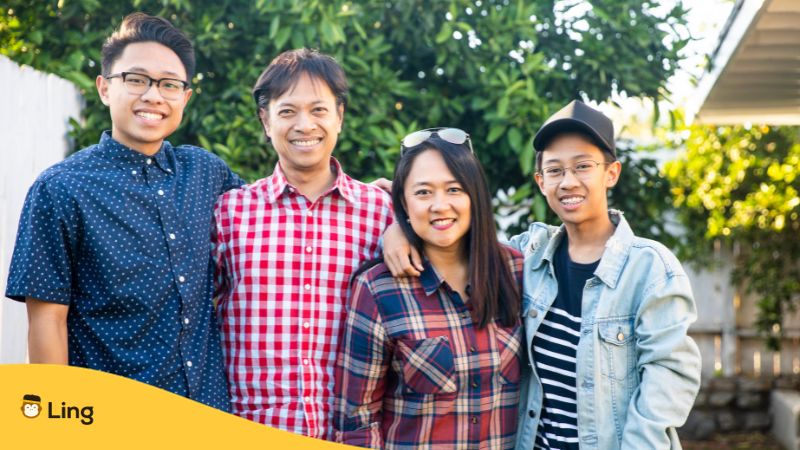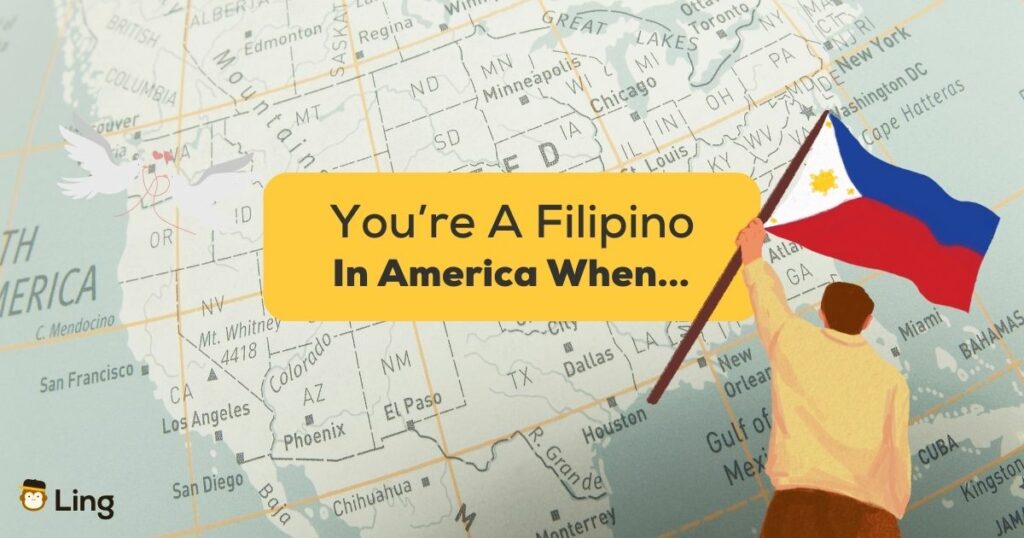If you’re a Filipino in America, you know certain things give away your heritage even as you blend into everyday life abroad. Sure, you may have ditched tinola for chicken noodle soup or traded adobo for the occasional meatloaf by now. But other classic elements of Pinoy culture? Those bad boys tend to linger!
Whether you just got your American citizenship last year or were born stateside, hilarious little moments still make you stop and think, “Yaaaas, that’s SO Filipino!” From keeping vats of rice permanently cooking on the stove to pointing with a distinctive mouth pucker, it’s the everydayness that connects Filipinos across oceans and generations.
Get pumped to nod along in “omg #sorelatable” recognition as we reveal the silly, smile-inducing times when your inner Pinoy just jumps out. Grab some pansit, halo-halo, or even just TFC Tagalog shows playing in the background as you dive into this list, guaranteed to bring some hearty LOLs.
Table Of Contents

You Know You’re A Filipino In America When…
As a Filipino in America, you live that hyphenated existence to the fullest. Sure, you blend more seamlessly into everyday American life than fresh-off-the-boat migrants did decades ago. These days you’re as fluent in pop culture references as hometown tales, English as comfortable as Tagalog once was.
But just when you think you’ve gone full Yankee Doodle without a trace of Pinoy left…PING! Some little thing happens that makes that Filipino spirit come aliiiive! Maybe you catch a whiff of sinigang from the neighbors’ kitchen. Or you hear someone call you “anak” at a wedding. Before you know it, you’re reacting in the most gloriously Filipino way ever!
You Eat Rice At Least Twice a Day—Minimum
Show of hands: who else has a rice cooker permanently on standby? Yuuup! Eating rice or kanin with pretty much every meal is just an absolute must as a Pinoy or Pinay. It also doesn’t matter if it’s first thing in the AM, lunch on your work break, or an evening pig-out session with the fam. A mound of fluffy, steaming rice has gotta be there waiting!
And you know just how deep this rice love goes for Pinoys? Well, they even managed to transform rice into DESSERT; that’s how real it is! From ube rice cakes (suman) to sticky rice wrapped in coconut or banana leaves (puto), we have all kinds of kakanin on deck! So don’t be surprised if you show up to a Fil-Am party or BBQ and spot many bilao (a traditional flat circular tray or basket) filled with these sweet rice delicacies.
You Dip Bread Into Coffee…Yup, Like Dunkin’ Donuts!
Look, everyone enjoys dunking donuts or cookies into their milk for added flavor. But there’s just something so iconically Pinoy about having pandesal, monay, or any regular sliced loaf as your dunkable bread of choice and using it to soak up that sweet, creamy coffee kick.
Maybe it takes you back to your lolas and lolos, tearing off morsels of tasty pandesal to plop right into their kapeng barako every morning. Or sitting down for an afternoon merienda break with friends to soak buttery ensaymada buns in tsokolate, eh?
However your favorite merienda or breakfast pairing goes, that satisfying dip + sip coffee tradition just runs too deep…to the point you’re doing it even when you’re in America!

You Always Go Home With Takeout Containers After Parties
Admit it: your cabinet is just filled to the brim with plastic takeout containers collected after countless Filipino parties over the years. It’s like the signature parting gift you can always count on! And there’s no denying those leftovers are almost better the next day, anyway.
You see, the Filipino culture holds food as an important aspect. So whether it’s Christmas noche buena feasts, New Year’s media noche buffets, or even just weekend potlucks and BBQs, Filipino homes have stacks of Tupperware ready. The idea here is that once the party is about to end and there is still food left, it’s a must to divide those evenly among the guests so they can take home some and continue the festivities at home.
You Order Balikbayan Boxes By January & Slowly Fill Them Through the Year
If you peep inside most Fil-Ams’ garages, you’ll find at least 3 jumbo balikbayan cardboard boxes in progress. After all, you gotta order those precious cargo containers months in advance! Then, slowly but surely, fill them with goods all year long before that December rush to ship ‘em back home.
Bags of chocolates in February? Toss it in! Cases of Spam for sale in spring? Stack ‘em up! Then come fall, cram in as many clothes, jackets, and branded perfumes that’ll zip. Oh, and don’t forget to send over shoes to make your box fit nicely and right.
Stuffing each box takes time and attention all year as you collect requested pharma goods, snacks, dry foods, and treats. But seeing your families’ faces light up? It makes it all worthwhile when your balikbayan arrives safe, stuffed, and right on time to spread the holiday cheer!
Your Nickname Is Still The Repeat Version Of Your First Syllable
You know you’re a Pinoy in America when someone yells out “Jo-Jo!” or “Mik-Mik!” and ten heads turn instinctively. Yup, we Filipinos just love those repetitive nicknames that basically summarize your whole given name into one or two bouncing syllables!
Maybe it started as childhood baby talk that just kinda stuck for life. Or perhaps your folks intentionally gave you a palindromic name to predestine the duplication. There’s just something so fun, catchy, and, well, efficient about identifying people as Jun-Jun, Vhing-Vhing, or Mae-Mae in social settings!
You Still Point With Your Lips
You know one of the biggest dead giveaways that you’re a Pinoy in America? That signature mouth-pointing maneuver we love so much! Yup, even with hands full of groceries, babies, car keys, or what have you…you’ll pucker up to point directions out for someone.
For most other cultures, pointing with the mouth or “pursing” seems odd when you have fully functional fingers. But for Filipinos who grew up in and out of conversations, kitchens, and social spaces where people’s hands were constantly occupied, it became an intuitive, efficient way to communicate. Most historians peg the origins back to ancient language in the Archipelago that didn’t have a specific word for “there.” So the visual gesture became shorthand to say “at that [place] over there.”

Why Are There Many Filipino Immigrants In The US?
With over 4 million Filipino-Americans today, people of Filipino descent represent the second largest Asian-American group in the country. But how exactly did this influential Filipino population and community come to establish deep roots stateside?
The long history of Filipinos in America traces back to October 1587 when “Luzones Indios,” likely Filipino sailors, first landed in what’s now Morro Bay, California. However, the first major wave of immigration began following the Spanish-American War when the Philippines became a U.S. territory in 1898.
The 1920s-30s also saw increasing numbers of Filipino immigrants—mostly young working-age men—arriving in search of jobs. As American demand for agricultural labor grew, Filipinos moved to states like California, Washington, and Alaska for work. Today, Filipino-Americans bolster many industries, from healthcare to education, defense, and more, while contributing vibrant aspects of Filipino culture.
Over To You!
Whether you just arrived stateside or have been rocking that hyphenated identity forever, those hilarious little moments will keep striking resonant chords. One whiff of sinigang or the sound of “Boom Tarat Tarat” on the radio, and suddenly, you feel the motherland calling again! Consider all the smells, songs, gestures, and tastes on this list as nostalgic triggers. Triggers that reconnect you to the fabric of Filipino traditions woven through American life.
So if you experienced major “gigil” (gleeful excitement) seeing your experiences reflected here, don’t forget to connect with your heritage even deeper! The Ling app makes learning Tagalog fun, easy, and customizable to your level. With it, you can finally rediscover the best words and phrases from your homeland through games, lessons, and quizzes.
Give it a try now!



































































